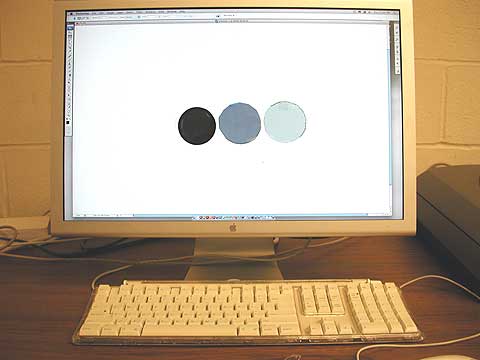|
Large
area source of polarized light for photography of plastic
objects.
Andrew Davidhazy Imaging and Photo Technology School of Photo Arts and Sciences / RIT The premise for this little tutorial is that sheet polarizers that one might place over a light box to do "stress analysis" photography are hard to find and if found not all that cheap. What alternatives are there to buying a large sheet polarizer? This article suggests that any LCD (liquid crystal display) screen provides a ready made source of polarized light. The screen itself can be used as the background polarizing material. LCD screens are constructed in such a manner that the last or one of the last items the light from the back of the display has to travel through is a polarizing filter. The LCD screen therefore becomes or behaves as a very good source of polarized light. The first step making the LCD screen become a useful and uniform source of polarized light is to arrange it so that the screen appears to have a uniform brightness or tone across its entire surface. Preferably white. There are various ways to achieve this. Creating an image file consisting of nothing but white is one way. Or choose a screen saver that is simply made up of a light tone or white. If the uniform tone has a color to it then that color will tint the ultimate results.  Look through a
regular polarizing filter at the LCD screen and rotate
it. You should note that the screen changes in brightness depending on
the orientation of the filter. In the illustration at left, several
filters were placed at different orientations over the LCD screen and
it is evident that the area of the screen behind them varies in
brightness.
Look through a
regular polarizing filter at the LCD screen and rotate
it. You should note that the screen changes in brightness depending on
the orientation of the filter. In the illustration at left, several
filters were placed at different orientations over the LCD screen and
it is evident that the area of the screen behind them varies in
brightness.Now place the filter over the camera lens and aiming the camera at the screen rotate the filter again and note that as when you used your eyes (or in the illustration at left) the screen changes in brightness depending on the orientation of the filter. Just as before. Further, you will see that the polarizing filter has little effect on anything surrounding the LCD screen but that the screen changes in brightness considerably as the filter is rotated. To visualize the effect that certain crystalline plastic materials, and indeed some glass materials, acquire when placed between the LCD screen and the polarizing filter on the camera just place an object such as a plastic tumbler, plastic eyeglasses, clear plastic tape dispenser, clear plastic toys, etc. in that location. Turning the polarizing filter on the camera lens will change not only the brightness of the background (the LCD screen) but also affect the colors or tones seen on the object you placed between them. This is a visualization of the stress patterns within the subject of interest. In this case a set of plastic wine glasses.  Generally for maximum effect you turn the filter on the camera until you have established as dark a condition as possible for the LCD screen and then you adjust the orientation of the subject for the most visually impactful orientation. On a side note, if you don't have a polarizing filter to fit over your camera lens you could use your polarizing sunglasses to examine the effect also to photograph through its "lenses" as well. The image quality may not be as good as if you photograph through optical glass filters but for many purposes it is acceptable. Further, you could conceivably also use the LCD screen as a source of polarized light when photographing subjects that would benefit from having the incident light be polarized (such as when photographing coins or paintings where the brushstrokes may hide certain details) although the level of illumination provided by an LCD screen is quite small. But if photographing small subjects this approach may be practical. At least from an improvisation point of view. It was also pointed out to me that if you find a non-working LCD screen that is about to be discarded, the device can be taken apart and the polarizing filter built into it can be removed and used to advantage, Just note I did not tell you to do this! It is merely an observation. Finally I should mention that after putting this piece together I decided to find out how widespread among photographers this approach to making stress patterns visible was. I thought that maybe a few would have thought of it and published about it but it turns out that a pretty large number of photographers were already aware of this approach. Well, so this is a repeat. But maybe you did not know about it and so this article may still have some value to you. By the way, there is another article devoted to improvising the making of large polarizers "on the cheap". Find it here http://people.rit.edu/andpph/text-polarizer-by-glare.html If you found this tidbit of
information useful and you want to let me know that or if you just want
to share some comments of your own feel free to drop me a line at:
Andrew Davidhazy, andpph@rit.edu |